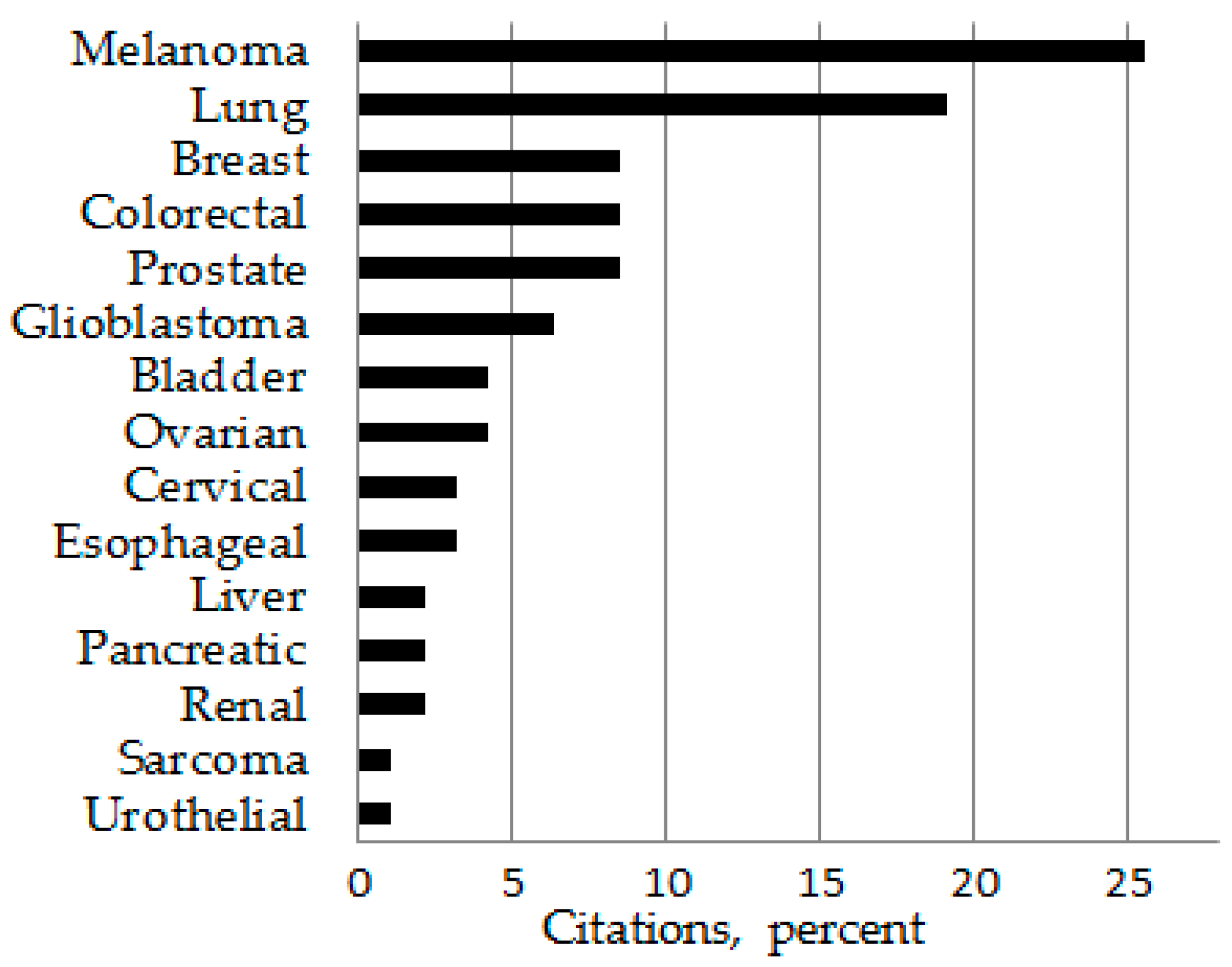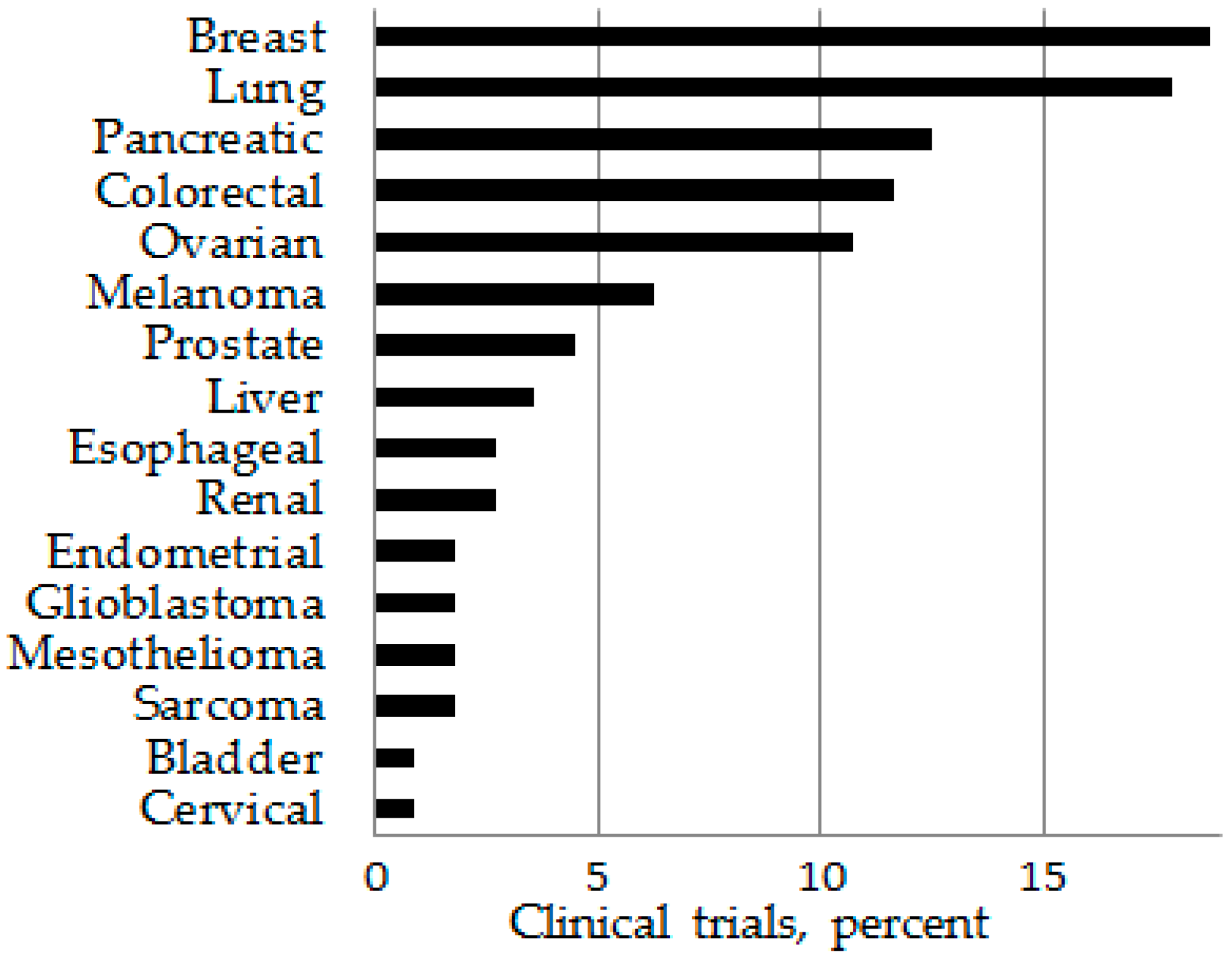Cancer Immunology with a Focus on Understudied Cancers as Targets for Immunotherapy
Conflicts of Interest
References
- Vanderstraeten, A.; Tuyaerts, S.; Everaert, T.; van Bree, R.; Verbist, G.; Luyten, C.; Amant, F. In Vitro Assessment of the Expression and T Cell Immunogenicity of the Tumor-Associated Antigens BORIS, MUC1, hTERT, MAGE-A3 and Sp17 in Uterine Cancer. Int. J. Mol. Sci. 2016, 17, 1525. [Google Scholar] [CrossRef] [PubMed]
- Tsai, W.-C.; Hueng, D.-Y.; Lin, C.-R.; Yang, T.C.K.; Gao, H.-W. Nrf2 Expressions Correlate with WHO Grades in Gliomas and Meningiomas. Int. J. Mol. Sci. 2016, 17, 722. [Google Scholar] [CrossRef] [PubMed]
- Esser, L.; Weiher, H.; Schmidt-Wolf, I. Increased Efficacy of Brentuximab Vedotin (SGN-35) in Combination with Cytokine-Induced Killer Cells in Lymphoma. Int. J. Mol. Sci. 2016, 17, 1056. [Google Scholar] [CrossRef] [PubMed]
- Gattoni-Celli, S.; Young, M.R.I. Restoration of Immune Responsiveness to Glioma by Vaccination of Mice with Established Brain Gliomas with a Semi-Allogeneic Vaccine. Int. J. Mol. Sci. 2016, 17, 1465. [Google Scholar] [CrossRef] [PubMed]
- Hojeij, R.; Domingos-Pereira, S.; Nkosi, M.; Gharbi, D.; Derré, L.; Schiller, J.T.; Jichlinski, P.; Nardelli-Haefliger, D. Immunogenic Human Papillomavirus Pseudovirus-Mediated Suicide-Gene Therapy for Bladder Cancer. Int. J. Mol. Sci. 2016, 17, 1125. [Google Scholar] [CrossRef] [PubMed]
- Li, N.; Li, Y.; Li, Z.; Huang, C.; Yang, Y.; Lang, M.; Cao, J.; Jiang, W.; Xu, Y.; Dong, J.; et al. Hypoxia Inducible Factor 1 (HIF-1) Recruits Macrophage to Activate Pancreatic Stellate Cells in Pancreatic Ductal Adenocarcinoma. Int. J. Mol. Sci. 2016, 17, 799. [Google Scholar] [CrossRef] [PubMed]
- Li, R.; Hu, S.; Chang, Y.; Zhang, Z.; Zha, Z.; Huang, H.; Shen, G.; Liu, J.; Song, L.; Wei, W. Development and Characterization of a Humanized Anti-HER2 Antibody HuA21 with Potent Anti-Tumor Properties in Breast Cancer Cells. Int. J. Mol. Sci. 2016, 17, 563. [Google Scholar] [CrossRef] [PubMed]
- Fabre, J.; Giustiniani, J.; Garbar, C.; Antonicelli, F.; Merrouche, Y.; Bensussan, A.; Bagot, M.; Al-Dacak, R. Targeting the Tumor Microenvironment: The Protumor Effects of IL-17 Related to Cancer Type. Int. J. Mol. Sci. 2016, 17, 1433. [Google Scholar] [CrossRef] [PubMed]
- Chan, C.W.H.; Tsui, S.K.W.; Law, B.M.H.; So, W.K.W.; Tang, F.W.K.; Wong, C.-L. The Utilization of the Immune System in Lung Cancer Treatment: Beyond Chemotherapy. Int. J. Mol. Sci. 2016, 17, 286. [Google Scholar] [CrossRef] [PubMed]
- Al-Hujaily, E.M.; Oldham, R.A.A.; Hari, P.; Medin, J.A. Development of Novel Immunotherapies for Multiple Myeloma. Int. J. Mol. Sci. 2016, 17, 1506. [Google Scholar] [CrossRef] [PubMed]
- Mittica, G.; Genta, S.; Aglietta, M.; Valabrega, G. Immune Checkpoint Inhibitors: A New Opportunity in the Treatment of Ovarian Cancer? Int. J. Mol. Sci. 2016, 17, 1169. [Google Scholar] [CrossRef] [PubMed]
- De Vries, N.L.; Swets, M.; Vahrmeijer, A.L.; Hokland, M.; Kuppen, P.J.K. The Immunogenicity of Colorectal Cancer in Relation to Tumor Development and Treatment. Int. J. Mol. Sci. 2016, 17, 1030. [Google Scholar] [CrossRef] [PubMed]
- Bansal, P.; Osman, D.; Gan, G.N.; Simon, G.R.; Boumber, Y. Recent Advances in Immunotherapy in Metastatic NSCLC. Front. Oncol. 2016, 6. [Google Scholar] [CrossRef] [PubMed]
- Zibelman, M.; Ramamurthy, C.; Plimack, E.R. Emerging Role of Immunotherapy in Urothelial Carcinoma-Advanced Disease. Urol. Oncol. 2016, 34, 538–547. [Google Scholar] [CrossRef] [PubMed]
- Menon, S.; Shin, S.; Dy, G. Advances in Cancer Immunotherapy in Solid Tumors. Cancers 2016, 8. [Google Scholar] [CrossRef] [PubMed]
- Dunn-Pirio, A.M.; Vlahovic, G. Immunotherapy Approaches in the Treatment of Malignant Brain Tumors. Cancer 2016. [Google Scholar] [CrossRef] [PubMed]
- Sukari, A.; Nagasaka, M.; Al-Hadidi, A.; Lum, L.G. Cancer Immunology and Immunotherapy. Anticancer Res. 2016, 36, 5593–5606. [Google Scholar] [CrossRef] [PubMed]
- Piulats, J.M.; Matias-Guiu, X. Immunotherapy in Endometrial Cancer: In the Nick of Time. Clin. Cancer Res. 2016, 22, 5623–5625. [Google Scholar] [CrossRef] [PubMed]


| Topic | Cancer Type | Focus | References |
|---|---|---|---|
| Targets and biomarkers | Uterine cancer | MUC1 and hTERT as T-cell targets | [1] |
| Primary brain cancers | Nuclear factor erythroid 2-related factor as a biomarker for cancer grade | [2] | |
| In vitro: Feasibility of treatment | Lymphoma | Combination of brentuximab vedotin (antibody-drug conjugate) plus cytokine-induced killer cells | [3] |
| In vivo: Treatment strategy | Brain glioma | Semi-allogeneic tumor vaccine | [4] |
| Bladder cancer | Intravesical papillomavirus non-replicative pseudovirions carrying thymidine kinase gene combined with Ganciclovir treatment | [5] | |
| Pancreatic ductal adenocarcinoma | HIF-1 to recruit inflammatory macrophages via CCL2 | [6] | |
| Breast cancer | Engineered anti-HER-2 A21 chimeric antibody | [7] |
© 2017 by the author; licensee MDPI, Basel, Switzerland. This article is an open access article distributed under the terms and conditions of the Creative Commons Attribution (CC-BY) license (http://creativecommons.org/licenses/by/4.0/).
Share and Cite
Young, M.R.I. Cancer Immunology with a Focus on Understudied Cancers as Targets for Immunotherapy. Int. J. Mol. Sci. 2017, 18, 127. https://doi.org/10.3390/ijms18010127
Young MRI. Cancer Immunology with a Focus on Understudied Cancers as Targets for Immunotherapy. International Journal of Molecular Sciences. 2017; 18(1):127. https://doi.org/10.3390/ijms18010127
Chicago/Turabian StyleYoung, M. Rita I. 2017. "Cancer Immunology with a Focus on Understudied Cancers as Targets for Immunotherapy" International Journal of Molecular Sciences 18, no. 1: 127. https://doi.org/10.3390/ijms18010127





